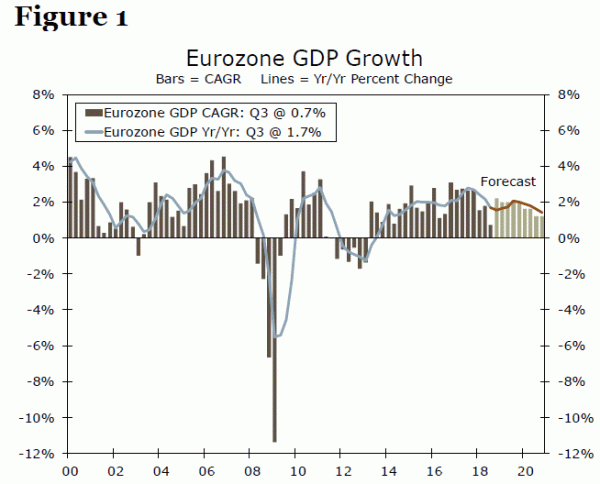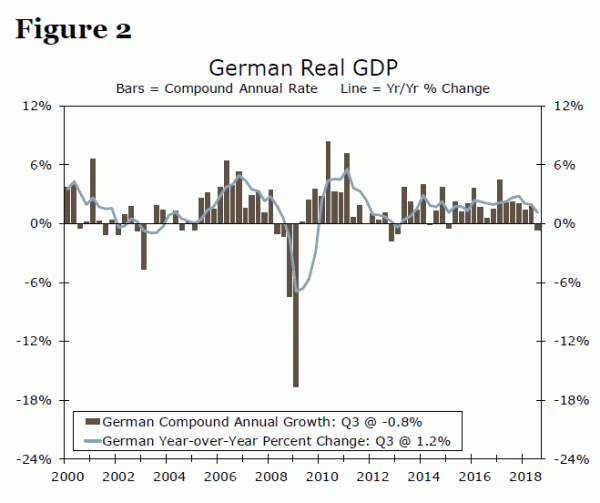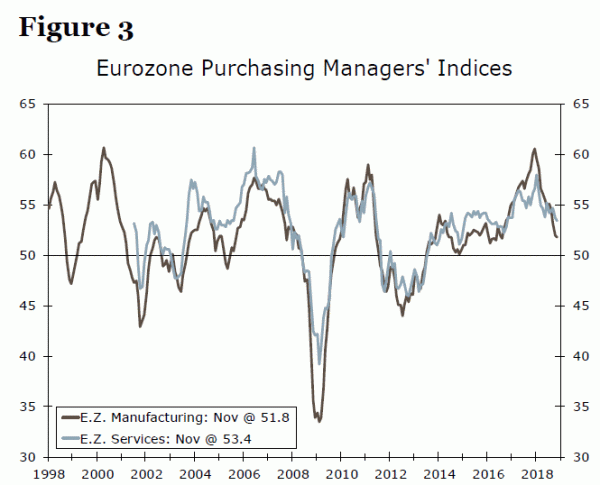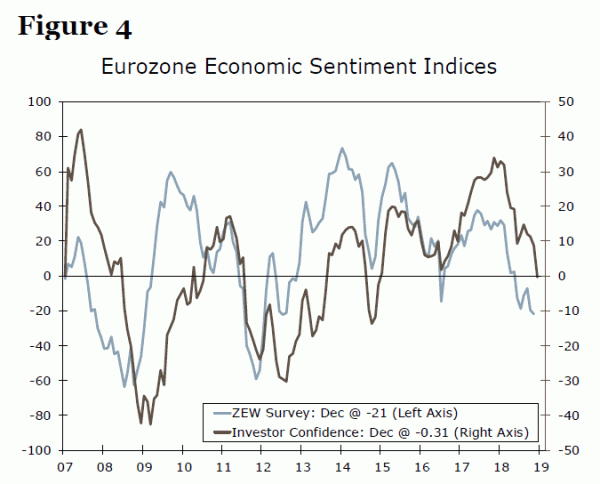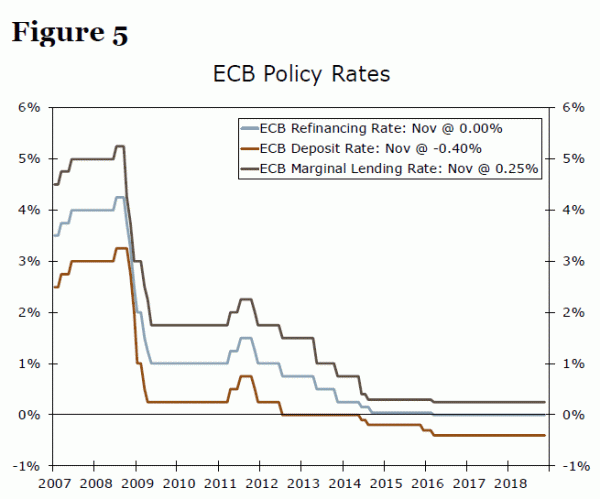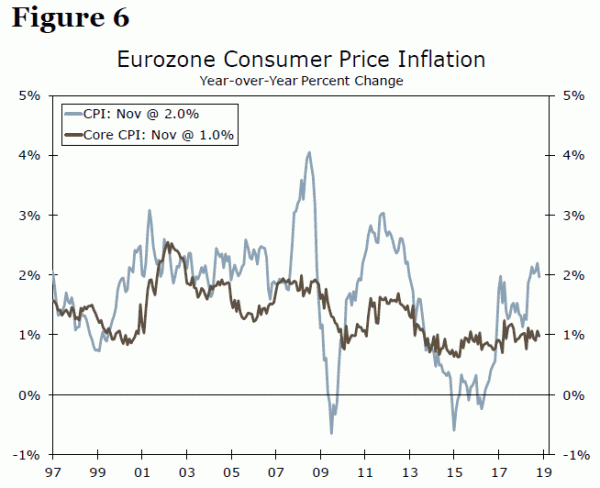Executive Summary
After a standout performance in 2017, economic growth across the Eurozone has decelerated through 2018. Several individual economies saw real GDP contract in Q3, leading market participants to question the strength and duration of the current expansion. We find that while some of the Q3 weakness was likely due to temporary factors, other higher-frequency indicators also point to a more pronounced slowdown. On net, while growth prospects could remain subdued in the near-term, the expansion should remain intact, and we look for rising wages and gains in broader consumer incomes to fuel economic growth in the coming quarters.
In terms of implications for monetary policy, market participants will likely be closely watching this week’s European Central Bank (ECB) monetary policy announcement for any effect that the slower pace of growth could have on the ECB’s plans to begin rolling back policy accommodation in coming quarters. While we look for the ECB to remain on hold this week, we still look for further monetary policy normalization in 2019, assuming the inflation and growth picture improve in coming months. In this report, we assess the recent economic slowdown and its effects on monetary policy and GDP growth prospects in the year ahead.
Europe’s Slowdown: Temporary or Permanent?
Economic growth in the Eurozone has slowed so far in 2018. Looking back at 2017, real GDP growth firmed steadily over the course of the year, with the 2.8% year-over-year gain registered in Q3-2017 the fastest pace since 2011. Compare that to the most recent print in Q3-2018 of 1.6%, and it is clear that growth has come off the boil this year (Figure 1). A closer look at several individual countries reinforces the sluggish pace of growth registered in Q3. For example, economic growth in Germany, the largest economy in the Eurozone, actually contracted in Q3 for the first time in more than four years (Figure 2).
In Italy, GDP also declined 0.1% (not annualized) in Q3 after only modest gains in the first half of the year, as that country also faces ongoing fiscal challenges amid pushback from the E.U. regarding its 2019 budget plans.1 While some of the Q3 weakness is likely due to temporary factors, which we discuss in more detail below, the slowdown in these countries is still likely a bellwether of the broader trend across Europe. Indeed, real GDP in Sweden and Switzerland, albeit smaller economies on the continent, also contracted 0.2% (not annualized) in each country in Q3.
So what are some likely explanations for the recent slowdown, and should we be concerned about longer-term growth prospects across Europe? As mentioned earlier, some of the Q3 weakness is likely due to one-off factors that affected auto purchases in the quarter. Indeed, German new passenger car registrations declined more than 30% in September, while data from other European countries including Italy and Sweden pointed to similar auto weakness over the month. Commentary from the German auto industry cited new emissions tests and fewer working days in the month as driving factors behind September’s large drop.2
At the same time, several other higher frequency indicators have also eased over the course of 2018, leading market participants to question if a slower pace of growth might continue in coming quarters. The Eurozone purchasing managers’ indices have fallen significantly this year, and are now only modestly in expansion territory (Figure 3). Readings of economic confidence have shown similar declines so far this year. For example, the expectations component of the ZEW survey dropped into negative territory in June and has remained there in recent months, signaling more respondents feel pessimistic than optimistic about the economic growth prospects over the next six months, while investor confidence has also moderated over the same time period (Figure 4).
Examining the higher frequency hard data yields largely the same result of a broader slowdown in growth in recent quarters. Industrial production growth has been tepid in 2018, with month-overmonth declines in six of nine months for which data is available this year. These data suggest that businesses could have fewer incentives to ramp up production in the midst of ongoing political and trade uncertainties occurring across the continent. At the same time, external demand has also weakened amid a generally slower global growth environment, and export growth has also decelerated this year.
Turning to the consumer side of the equation, the picture looks a bit more encouraging. The labor market continues to improve, with the unemployment rate currently sitting at a 10-year low of 8.1% in October. At the same time, stronger wage growth has finally begun to materialize. Recentlyreleased data showed that wages rose at their fastest pace of the current expansion in Q3, with compensation per employee up 2.5% year over year. Relatively low inflation has also likely supported consumers’ purchasing power, and consumers have likely been buoyed by interest rates that remain at historic lows. While demand-side detail in the Q3 GDP data showed that consumer spending rose at a modest 0.1% pace in the quarter, it appears that consumers are still wellpositioned to support economic growth going forward amid a continued pickup in wages.
What Does the Recent Slowdown Mean for the ECB?
As overall economic growth has slowed so far this year, monetary policy in the Eurozone has remained highly accommodative, with the ECB’s deposit rate still in negative territory (Figure 5). The ECB’s Governing Council has stated that it intends to wrap up its bond-buying program at the end of the year, but keep rates unchanged through at least the summer of 2019. However, these plans rely on the inflation and growth picture improving in coming months. While the growth outlook looks somewhat murky, price pressures also remain muted and have held the ECB back from a more rapid removal of monetary policy accommodation. To that end, we look for the ECB to remain on hold at its upcoming meeting, as it has already signaled that it plans to leave rates unchanged for the time being, while incoming data have also largely confirmed this stance, in our view. Although headline CPI inflation is actually above the ECB’s target of “below, but close to 2%,” core inflation has been subdued and stuck near 1% over the past several years, signaling that underlying inflationary pressures have gained little momentum so far in this expansion (Figure 6). At the same time, the sharp drop in global oil prices registered in recent weeks could prove a further drag on headline inflation over the next few months.
In the longer-term however, rising wages and continued above potential economic growth should push up prices, likely prompting the ECB to tighten monetary policy. The Q3 labor compensation data mentioned above should put upward pressure on inflation, and likely re-affirms the ECB’s plans to begin slowly normalizing monetary policy, even given the recent soft patch in GDP growth. With these trends in mind, we take the ECB at its word that it will end bond purchases this year, then gradually begin to raise rates in Q3 of next year. We look for two 20-bp rate increases in the deposit rate in Q3 and Q4 2019, such that the deposit rate returns to 0% by the end of 2019. Meanwhile the ECB should also raise its refinancing rate starting in Q4-2019 with a 25-bp hike to 0.25%. However, should the recent slowdown in growth persist for an extended period of time, these plans may take longer to come to fruition.
Conclusion
Real GDP growth in the Eurozone has downshifted so far this year after the more solid pace of growth seen in 2017. Several countries saw outright contractions in output in the third quarter, and while some of the weakness was likely due to temporary factors, the recent stagnation has led many to question the durability of the present expansion. But in our view, the underlying health of the Eurozone economy should display resilience in coming quarters. Consumer spending will likely rebound, buoyed by accelerating wage growth. While the ECB has remained accommodative amid continued sluggish price pressures and the recent growth slowdown, we still look for it to wrap up its bond purchases at the end of this year before beginning to slowly raise rates from the fall of 2019. Price pressures should slowly pick up as labor costs continue to rise and monetary policy becomes tighter after several years of historically low interest rates. The fundamentals of the Eurozone economy should remain intact, in our view, and we look for real GDP to rise 1.9% in 2019 and 1.7% in 2020.
1 Pugliese, M., Nelson, E. and Bennenbroek, N. “What’s Next for Italy’s Budget?” (November 30, 2018) and Pugliese, M., Nelson, E. and Bennenbroek, N. “Italy Takes Another Step Towards Fiscal Easing,” (October 01, 2018).
2 “Expected Downturn on the German Passenger Car Market.” (October 2, 2018). German Association of the Automotive Industry.




